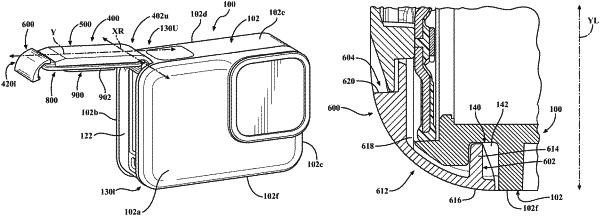| CPC G03B 17/08 (2013.01) [G03B 2217/002 (2013.01); G03B 2217/007 (2013.01)] | 20 Claims |

|
1. An image capture device comprising:
a body defining a peripheral cavity; and
a door assembly configured to close and seal the peripheral cavity, the door assembly being movable between an open position and a closed position, and including:
a door body including an engagement structure configured for removable connection to the body of the image capture device;
a locking mechanism linearly slidable in relation to the door body between a locked position, in which the door assembly is rotationally fixed in relation to the body of the image capture device to inhibit movement of the door assembly from the closed position to the open position, and an unlocked position, in which the door assembly is rotatable in relation to the body of the image capture device to allow for movement of the door assembly from the closed position to the open position; and
a biasing member configured for engagement with the locking mechanism to resist movement of the locking mechanism from the locked position to the unlocked position until a threshold force is applied to the locking mechanism, the biasing member configured for movement between a normal position and a deflected position upon application of the threshold force, the biasing member extending at a first angle in relation to the locking mechanism in the normal position and at a second angle in relation to the locking mechanism in the deflected position, and the first angle being greater than the second angle.
|